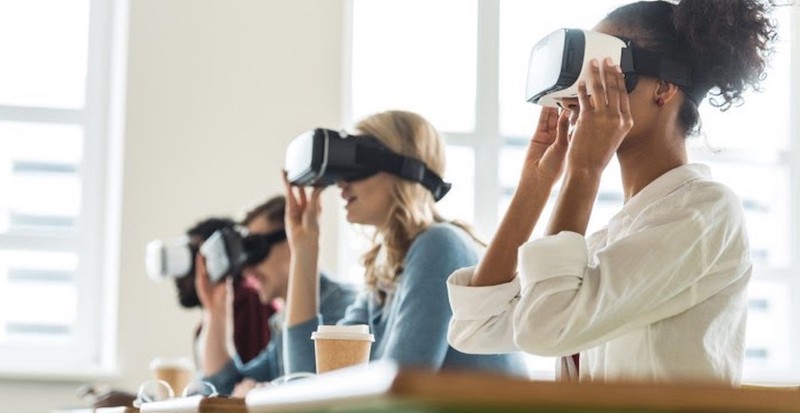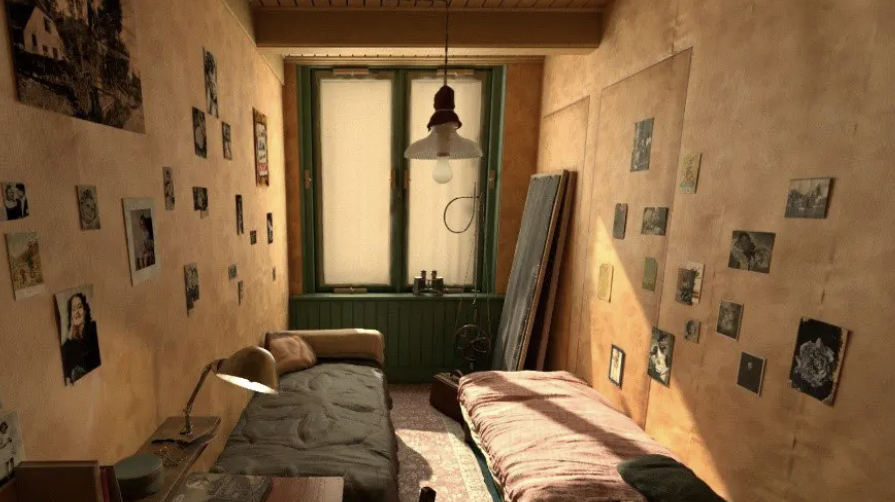The landscape of virtual reality in education continues to evolve. Virtual solutions, such as the RobotLAB VR Expeditions 2.0 platform, help educators synthesize multiple 21st-century learning elements, including global awareness and collaboration. It can even help redefine how kids learn other soft skills, like empathy, since these immersive experiences often place them in situations that will challenge their worldviews. Plus, integrating VR in the classroom has a number of educational and logistical benefits. These tools often help students create connections between concepts, driving new interests and discoveries. Those connections make VR especially viable for cross-curricular learning in STEM classes, CTE programs, and more.
Starting Out with VR in Education
Getting started with VR may feel overwhelming, but with plenty of places to add virtual experiences into the curriculum, it's easy to integrate. First, though, educators may need to survey parents and students to ensure kids aren't prone to motion sickness. Once they get the green light, they can use virtual reality as a tool for taking learning beyond the classroom walls. But, it's not only the enhanced imagery that makes VR a beneficial tech tool. VR helps amplify student engagement, boost student retention, and even assist students in blocking out various learning distractions thanks to its powerful immersive features. Plus, kids can now learn experientially rather than simply being fed content.
Tethered vs. untethered experiences.
There are two main types of virtual reality systems available: tethered headsets and untethered headsets. Untethered headsets are typically more simplistic, compact, and affordable. They can also provide children with every opportunity to move around freely during use. Adding in movement (as long as they won't bump into each other or anything else) helps boost engagement and energy, while adding in flexibility for different classroom layouts. The RobotLAB VR headsets, for example, are one of the latest examples of untethered experiences. On the flip side, the tethered systems are typically more powerful since the connecting cables can transmit larger amounts of data. It's a bit of a tradeoff, but each certainly has benefits for students.
Using VR in different subjects.
As for their learning experiences themselves, VR is viable in an increasing number of subjects. Take history, for example. Although the humanities are not always associated with STEM or technology, VR can certainly enhance history lessons anyway. Students could use a virtual reality headset for up-close exploration of an ancient civilization or ecological environment. Alternatively, they can use VR to encounter historic paintings or architecture, thus incorporating the arts. They may even use VR to work on soft skills, like collaboration or communication. Finally, for older students, VR tools enable detailed science experiences in many areas, like natural science, biology, and engineering. And that only scratches the surface of the capabilities of VR.
Why VR Can Affect Learning in a Positive Way
Virtual reality offers a wide variety of learning experiences, differentiated largely by student ages and ability. Younger students, for example, might use VR to access basic visualizations of broad topics. Older children, on the other hand, may use it to partake in advanced simulations. In either case, virtual reality provides the educators with an opportunity to redefine how they deliver important content. VR does more than increase a student's access to relevant information. The resulting experiences offer a revamped opportunity for the students—one that's based on personal investment rather than just retention and comprehension.
Why virtual reality offers more than consumption.
Typically, instructional experiences involve making sure children retain information. Although learning facts and figures may be necessary to maintain standards and track progress, this approach can leave students unengaged. In today's world, simply having access to a lot of facts doesn't equate to deep learning. While students certainly can access new information through their lessons, that isn't always necessarily the type of education they need—especially when they can use tools like search engines and artificial intelligence to find the same information.
Instead, creating memorable learning experiences allows students to attach actual meaning to the lessons. Absorbing information through rote memorization can overwhelm them, creating boredom, disengagement, or withdrawal. VR experiences provide a fresh alternative and also allow children to not only visualize what they are learning but also directly interact with it. They also cultivate personal investment in the information, which fosters retention. (Perhaps they'll even tell their families more than only a sentence or two about their day at school). Plus, when students practice gleaning significance from real-world experiences, they will be more prepared to apply what they've learned to their daily lives.
The value of experiential learning.
Virtual reality systems help enable kids to enter a new and immersive dimension of their education—one in which they are interacting with this content and remaining motivated to discover more. In some of the best VR lessons, students do not need to utilize as much cognitive power to process important information. VR experiences often provide students with an improved sense of place and help them learn various things by experiencing them. Students can also put what they're learning to scale—something that is much tougher in traditional classrooms. Finally, VR helps kids learn by doing, establish emotional connections, and even embrace new technologies.

Which Educational VR Tools to Use
As we've discussed, there are countless benefits to using VR in education. For the average student, virtual reality tools can help create a new sense of excitement and often lead to deeper levels of engagement. For students with learning differences, however, it could also do amazing things with retention and focus. VR can improve how children understand complex topics through first-hand experiences, amplify engagement with immersion, and allow students to enjoy experiences that would likely not fit in school budgets or even be physically reachable. The educational value is immense. So, how do educators begin when integrating VR into the classroom?
Physical or digital: What kind of VR to choose?
With so many VR tools now available, it can be overwhelming for tech leaders to settle on something to try. If you explore our blog and store, you can find input on both these physical VR systems and online digital tools. Students can often access these tools on a 1:1 basis, and choosing one depends on your classroom setup, student preferences, budget, and more. For physical tools, Expeditions 2.0 is one incredible option. Its advanced VR system features guided lessons, tours, and incredible imagery on a variety of topics.
More VR tools to check out.
VR experiences are also easy for students to access on mobile devices. Platforms like Flipgrid, CoSpaces Edu, Nearpod, and lots of others are designed specifically for simplicity, approachability, and engagement. Plus, with these tools, students aren't just consuming content. They often have the chance to fully create it themselves, putting their creative touch on various projects. Many fully online VR platforms, like Panoform or HistoryMaker, allow kids creative freedom while making virtual experiences more accessible. You could also check out more intriguing AR and VR tools, such as QuiverVision, 3D Bear, Thinglink, and others.
Using VR Throughout the Curriculum
When it comes to designing lessons specifically around VR resources, teachers might be surprised about all the areas in which it's viable. Virtual reality hardware and content can help enhance understanding and engagement across much of the curriculum. Teachers can use VR tools to supplement instruction in most subjects, but the most common are science and history. VR experiences help spark an interest in STEAM and help children develop spatial intelligence. This means that they can better recall visual images, which would serve them well in a STEM future. Or, using VR for history lessons can increase students' empathy for people from other cultures and their understanding of cause and effect.
VR content for science and history.
Different VR content is available on different systems, but using one of our favorites, the Expeditions 2.0, you can easily customize virtual learning. Footage from 360º cameras and the Google Street View content allows educators to create their own virtual reality tours. Go around the world to explore locations relevant to any lesson. Or, choose from the existing VR field trips to provide students a first-hand look at museums, outer space, or the depths of the oceans. With unique ability to play ambient sounds or discuss interactive prompts, Expeditions is a great virtual tool to help kids connect to content on a deeper emotional level.
Using interaction to provide context.
In other areas, there is VR content available from some of the most well-known names in education. This includes National Geographic, Google, and more. Teachers can transport students directly to each of the world's seven wonders or dive deep into the ocean and explore the wreckage of the Titanic. They could channel Miss Frizzle and travel through the inside of the human body to learn all about the many systems and functions from up close. While the visuals and interaction with all these experiences are great, it's the context they provide to students that is ultimately what makes them so valuable. They might gain a basic understanding of what they're learning about, but exploring this knowledge within the actual environment can exponentially amplify retention.

Virtual Learning Experiences and Students
The importance of virtual reality in education varies greatly. With some students, it can be a gateway into a world of brand-new engagement and excitement. For others, VR can be a catalyst for making interpersonal connections as children share experiences. Despite this effectiveness, VR still isn't all that common in K-12 classrooms. It's still fairly new, so there are undoubtedly educators and administrators who would be a little apprehensive about investing in it. Besides content and up-close views, however, VR experiences also help teachers capture kids' attention. And, in an era in which that's increasingly difficult, it could be an equalizer.
Benefits beyond academics and engagement.
We've talked a lot about increasing student engagement using VR, and rightfully so. This might be its No. 1 benefit in the classroom, but there are others as well. Virtual reality education apps and their experiences provide students with increased opportunities for socialization, collaboration, and active learning. As we all continue to emphasize the need for social-emotional balance for today's students, VR tools can also help them grow and care more deeply about curricular content, create connections to their own lives, empathize with other people's situations, and learn to communicate their many thoughts and feelings more effectively. Besides that, VR content enables students to truly engage with the stories teachers tell through lessons.
With the right tools, learning can shift for the better.
In (actual) reality, the types of educational experiences in which students get to partake are, unfortunately, sometimes limited. With VR, however, that ceiling is lifted, allowing them to explore content and views like they couldn't before. Knowing that they're immersed in actual scenes from real places all around the world can help students understand things more clearly. As a result, while the style in which students are learning shifts, they can access new levels of knowledge and immersion, prompting a truly revolutionized classroom experience. If you're interested in outfitting your school or library with some educational VR tools, we invite you to contact us. We'd love to learn about your goals, budget, and space and share recommendations!
For the latest EdTech, STEM, and 21st century education news, follow us on Twitter and Instagram. Like us on Facebook, too, or sign up for our newsletter for our latest product announcements and offerings. If you have an idea for an Eduporium Weekly theme, send us a message on social media or comment below.







